Electrochemical Performance of Graphene-Modulated Sulfur Composite Cathodes Using LiBH4 Electrolyte for All-Solid-State Li-S Battery
Abstract
:1. Introduction
2. Materials and Methods
2.1. Synthesis of GO-S and rGO-S Nanocomposites
2.2. Electrode Material Preparation
2.3. Coin Cell Preparation
2.4. Material Characterization and Electrochemical Measurements
3. Results and Discussion
3.1. X-ray Diffraction
3.2. SEM Analysis
4. Conclusions
Supplementary Materials
Author Contributions
Funding
Data Availability Statement
Acknowledgments
Conflicts of Interest
References
- Zhao, Y.; Zhang, Y.; Bakenova, Z.; Bakenov, Z. Carbon/sulfur composite cathodes for flexible lithium/sulfur batteries: Status and prospects. Front. Energy Res. 2015, 3, 1–6. [Google Scholar] [CrossRef] [Green Version]
- Ismail, A.M.; Mohammed, M.I.; Fouad, S.S. Optical and structural properties of polyvinylidene fluoride (PVDF)/reduced graphene oxide (RGO) nanocomposites. J. Mol. Struct. 2018, 1170, 51–59. [Google Scholar] [CrossRef]
- Scrosati, B.; Garche, J. Lithium batteries: Status, prospects and future. J. Power Sources 2010, 195, 2419–2430. [Google Scholar] [CrossRef]
- Whittingham, M.S. Lithium Batteries and Cathode Materials. Chem. Rev. 2004, 104, 4271–4301. [Google Scholar] [CrossRef]
- Hassoun, J.; Scrosati, B. Moving to a solid-state configuration: A valid approach to making Li-S batteries viable for practical applications. Adv. Mater. 2010, 22, 5198–5201. [Google Scholar] [CrossRef] [PubMed]
- Cheon, S.E.; Ko, K.S.; Cho, J.H.; Kim, S.W.; Chin, E.Y.; Kim, H.T. Facile preparation and electrochemical properties of carbon-enfolded sulfur particles for Li-S battery application. J. Electrochem. Soc. A 2003, 150, 796–799. [Google Scholar] [CrossRef]
- Ji, L.; Rao, M.; Aloni, S.; Wang, L.; Cairns, E.J.; Zhang, Y. Porous carbon nanofiber-sulfur composite electrodes for lithium/sulfur cells. Energy Environ. Sci. 2011, 4, 5053–5059. [Google Scholar] [CrossRef]
- Wang, H.; Yang, Y.; Liang, Y.; Robinson, J.T.; Li, Y.; Jackson, A.; Cui, Y.; Dai, H. Graphene-Wrapped Sulfur Particles as a Rechargeable LithiumSulfur Battery Cathode Material with High Capacity and Cycling Stability. Nano Lett. 2011, 11, 2644–2647. [Google Scholar] [CrossRef] [Green Version]
- Wei, S.; Zhang, H.; Huang, Y.; Wang, W.; Xia, Y.; Yu, Z. Pig bone derived hierarchical porous carbon and its enhanced cycling performance of lithium-sulfur batteries. Energy Environ. Sci. 2011, 4, 736–740. [Google Scholar] [CrossRef]
- Sun, H.; Xu, G.L.; Xu, Y.F.; Sun, S.G.; Zhang, X.; Qiu, Y.; Yang, S. Composite of sulfur impregnated in porous hollow carbon spheres as the cathode of Li-S batteries with high performance. Nano Res. 2012, 5, 726–738. [Google Scholar] [CrossRef] [Green Version]
- Liang, C.; Dudney, N.J.; Howe, J.Y. Hierarchically Structured Sulfur/Carbon Nanocomposite Material for High-Energy Lithium Battery. Chem. Mater. 2009, 21, 4724–4730. [Google Scholar] [CrossRef]
- Jung, D.S.; Hwang, T.H.; Lee, J.H.; Koo, H.Y.; Shakoor, R.A.; Kahraman, R.; Jo, Y.N.; Park, M.S.; Choi, J.W. Hierarchical Porous Carbon by Ultrasonic Spray Pyrolysis Yields Stable Cycling in Lithium–Sulfur Battery. Nano Lett. 2014, 14, 4418–4425. [Google Scholar] [CrossRef]
- Dash, R.; Chmiola, J.; Yushin, G.; Gogotsi, Y.; Laudisio, G.; Singer, J.; Fischer, J.; Kucheyev, S. Titanium Carbide Derived Nanoporous Carbon for Energy-Related Applications. Carbon 2006, 44, 2489–2497. [Google Scholar] [CrossRef] [Green Version]
- Li, Q.; Zhou, C.; Ji, Z.; Han, B.; Feng, L.; Wu, J. High-performance lithium/sulfur batteries by decorating CMK-3/S cathodes with DNA. J. Mater. Chem. A 2015, 3, 7241–7247. [Google Scholar] [CrossRef]
- Kim, H.; Lim, H.D.; Kim, J.; Kang, K. Graphene for advanced Li/S and Li/air batteries. J. Mater. Chem. A 2014, 2, 33–47. [Google Scholar] [CrossRef]
- Patodia, T.; Sharma, K.B.; Dixit, S.; Katyayan, S.; Agarwal, G.; Jain, S.K.; Saini, C.L.; Tripathi, B. Physico-Chemical Analysis of GO-S and rGO-S Composites as Electrodes for Flexible Li-S Battery. Adv. Sci. Eng. Med. 2021, 12, 1080–1083. [Google Scholar] [CrossRef]
- Cao, Y.; Li, X.; Aksay, I.A.; Lemmon, J.; Nie, Z.; Yang, Z.; Liu, J. Sandwich-type functionalized graphene sheet-sulfur nanocomposite for rechargeable lithium batteries. Phys. Chem. Chem. Phys. 2011, 13, 7660–7665. [Google Scholar] [CrossRef] [PubMed]
- Ji, X.; Nazar, L.F. Advances in Li-S batteries. J. Mater. Chem. 2010, 20, 9821–9826. [Google Scholar] [CrossRef]
- Tripathi, B.; Martinez, M.L.V.; Katiyar, R.K.; Sharma, K.B.; Ram, S.K. Scalable Study on Nanostructured Carbon-Sulfur Composite Electrodes for High Energy Lithium Sulfur (Li-S) Battery. ECS Trans. 2017, 77, 47–57. [Google Scholar] [CrossRef]
- Yu, P.; Xiao, Z.C.; Wang, Q.Y.; Pei, J.K.; Niu, Y.H.; Bao, R.Y.; Wang, Y.; Yang, M.B.; Yang, W. Advanced Graphene@Sulfurcomposites via an in-situ reduction and wrapping strategy for high energy density lithium-sulfur batteries. Carbon 2019, 150, 224–232. [Google Scholar] [CrossRef]
- Hsieh, Y.Y.; Zhang, L.; DeArmond, D.; Kanakaraj, S.N.; Adusei, P.K.; Alvarez, N.T.; Fang, Y.; Daum, J.; Shanov, V. Integrated graphene-sulfur cathode and separator with plasma enhancement for Li-S batteries. Carbon 2018, 139, 1093–1103. [Google Scholar] [CrossRef]
- Zhang, Y.; Zhao, Y.; Yermukhambetova, A.; Bakenov, Z.; Chen, P. Ternary sulfur/polyacrylonitrile/Mg0.6Ni0.4O composite cathodes for high performance lithium/sulfur batteries. J. Mater. Chem. A 2013, 1, 295–301. [Google Scholar] [CrossRef] [Green Version]
- Kolosnitsyn, V.; Karaseva, E. Lithium-Sulfur Batteries: Problems and Solutions. Russ. J. Electrochem. 2008, 44, 506–509. [Google Scholar] [CrossRef]
- Jayaprakash, N.; Shen, J.; Moganty, S.S.; Corona, A.; Archer, L.A. Porous Hollow Carbon-Sulfur Composites for High-Power Lithium-Sulfur Batteries. Chem. Int. Ed. 2011, 50, 5904–5908. [Google Scholar] [CrossRef] [PubMed]
- Zhen, H.; Bo, T.L.; Jian, W.; An, C.-S.; Bin, X.; Chao, Z.J. Synthesis and characterization of a sulfur/TiO2 composite for Li-S battery. J. Phys. Chem. C 2018, 122, 8769–8779. [Google Scholar]
- Singh, R.; Kumari, P.; Rathore, R.K.; Shinzato, K.; Ichikawa, T.; Jain, A.; Kumar, M. LiBH4 as solid electrolyte for Li-ion batteries with Bi2Te3 nanostructured anode. Int. J. Hydrogen Energy 2018, 43, 21709–21714. [Google Scholar] [CrossRef]
- William, S.H.; Richard, O.E. Preparation of Graphitic Oxide. J. Am. Chem. Soc. 1958, 80, 1339. [Google Scholar]
- Sveinbjornsson, S.; Christiansen, A.S.; Viskinde, R.; Norby, P.; Vegge, T. The LiBH4-LiI Solid Solution as an Electrolyte in an All-Solid-State Battery. J. Electrochem. Soc. A 2014, 161, 1432–1439. [Google Scholar] [CrossRef]
- Nagao, M.; Imade, Y.; Narisawa, H.; Kobayashi, T. All-solid-state Li-S batteries with mesoporous electrode and thio-LISICON solid electrolyte. J. Power Sources 2013, 222, 237–242. [Google Scholar] [CrossRef]
- Kumari, P.; Awasthi, K.; Agarwal, S.; Ichikawa, T.; Kumar, M.; Jain, A. Flower-like Bi2S3 nanostructures as highly efficient anodes for all-solid-state lithium-ion batteries. RSC Adv. 2019, 9, 29549–29555. [Google Scholar] [CrossRef] [Green Version]
- Kumari, P.; Singh, R.; Awasthi, K.; Ichikawa, T.; Kumar, M.; Jain, A. Highly stable nanostructured Bi2Se3 anode material for all solid-state lithium-ion batteries. J. Alloys Compd. 2020, 838, 155403. [Google Scholar] [CrossRef]
- Jin, J.; Wen, Z.; Ma, G.; Lu, Y.; Cui, Y.; Wu, M.; Liang, X.; Wu, X. Flexible self-supporting graphene-sulfur paper for lithium sulfur batteries. RSC Adv. 2013, 3, 2558–2560. [Google Scholar] [CrossRef]
- Evers, S.; Nazar, L.F. Graphene-enveloped sulfur in a one pot reaction: A cathode with good coulombic efficiency and high practical sulfur content. Chem. Commun. 2012, 48, 1233–1235. [Google Scholar] [CrossRef] [PubMed]
- Zhang, F.F.; Zhang, X.B.; Dong, Y.H.; Wang, L.M. Facile and effective synthesis of reduced graphene oxide encapsulated sulfur via oil/water system for high performance lithium sulfur cells. J. Mater. Chem. 2012, 22, 11452–11454. [Google Scholar] [CrossRef]
- Wang, Y.X.; Huang, L.; Sun, L.C.; Xie, S.Y.; Xu, G.L.; Chen, S.R.; Xu, Y.F.; Li, J.T.; Chou, S.L.; Dou, S.X.; et al. Facile synthesis of a interleaved expanded graphite-embedded sulphur nanocomposite as cathode of Li-S batteries with excellent lithium storage performance. J. Mater. Chem. 2012, 22, 4744–4750. [Google Scholar] [CrossRef] [Green Version]
- Ying, K.; Tian, R.; Zhou, J.; Li, H.; Dugnani, R.; Lu, Y.; Duan, H.; Guo, Y.; Liu, H. A three dimensional sulfur/reduced graphene oxide with embedded carbon nanotubes composite as a binder-free, free-standing cathode for lithium-sulfur batteries. RSC Adv. 2017, 7, 43483–43490. [Google Scholar] [CrossRef] [Green Version]
- Chen, H.L.; Xiao, Z.J.; Zhang, N.; Xiao, S.Q.; Xia, X.G.; Xi, W.; Wang, Y.C.; Zhou, W.Y.; Xie, S.S. Free-standing, curled and partially reduced graphene oxide network as sulfur host for high-performance lithium-sulfur batteries. Chin. Phys. B 2018, 27, 068101. [Google Scholar] [CrossRef]
- Xi, K.; Kidambi, P.R.; Chen, R.; Gao, C.; Peng, X.; Ducati, C.; Hofmann, S.; Kumar, R.V. Binder free three-dimensional sulphur/few-layer graphene foam cathode with enhanced high-rate capability for rechargeable lithium sulphur batteries. Nanoscale 2014, 6, 5746–5753. [Google Scholar] [CrossRef] [PubMed] [Green Version]
- Lin, T.; Tang, Y.; Wang, Y.; Bi, H.; Liu, Z.; Huang, F.; Xie, X.; Jiang, M. Scotch-tape-like exfoliation of graphite assisted with elemental sulfur and graphene-sulfur composites for high-performance lithium-sulfur batteries. Energy Environ. Sci. 2013, 6, 1283–1290. [Google Scholar] [CrossRef]
- Ding, B.; Yuan, C.; Shen, L.; Xu, G.; Nie, P.; Lai, Q.; Zhang, X. Chemically tailoring the nanostructure of graphene nanosheets to confine sulfur for high-performance lithium-sulfur batteries. J. Mater. Chem. A 2013, 1, 1096–1101. [Google Scholar] [CrossRef]
- Jin, K.; Zhou, X.; Zhang, L.; Xin, X.; Wang, G.; Liu, Z. Sulfur/carbon nanotube composite film as a flexible cathode for lithium-sulfur batteries. J. Phys. Chem. C 2013, 117, 21112–21119. [Google Scholar] [CrossRef]
- Hagen, M.; Dörfler, S.; Althues, H.; Tübke, J.; Hoffmann, M.J.; Kaskel, S.; Pinkwart, K. Lithium-sulphur batteries—Binder free carbon nanotubes electrode examined with various electrolytes. J. Power Sources 2012, 213, 239–248. [Google Scholar] [CrossRef]
- Patodia, T.; Sharma, K.B.; Dixit, S.; Katyayan, S.; Agarwal, G.; Jain, A.; Jain, S.K.; Tripathi, B. Carbon nanotube-sulfur nanocomposite electrodes for high energy-foldable lithium sulfur battery. Mater. Today Proc. 2019, 42, 1638–1641. [Google Scholar] [CrossRef]
- Unemoto, A.; Yasaku, S.; Nogami, G.; Tazawa, M.; Taniguchi, M.; Matsuo, M.; Ikeshoji, T.; Orimo, S.I. Development of bulk-type all-solid-state lithium-sulfur battery using LiBH4 electrolyte. Appl. Phys. Lett. 2014, 105, 083901. [Google Scholar] [CrossRef]
- López-Aranguren, P.; Berti, N.; Dao, A.H.; Zhang, J.; Cuevas, F.; Latroche, M.; Jordy, C. An all-solid-state metal hydride—Sulfur lithium-ion battery. J. Power Sources 2017, 357, 56–60. [Google Scholar] [CrossRef]
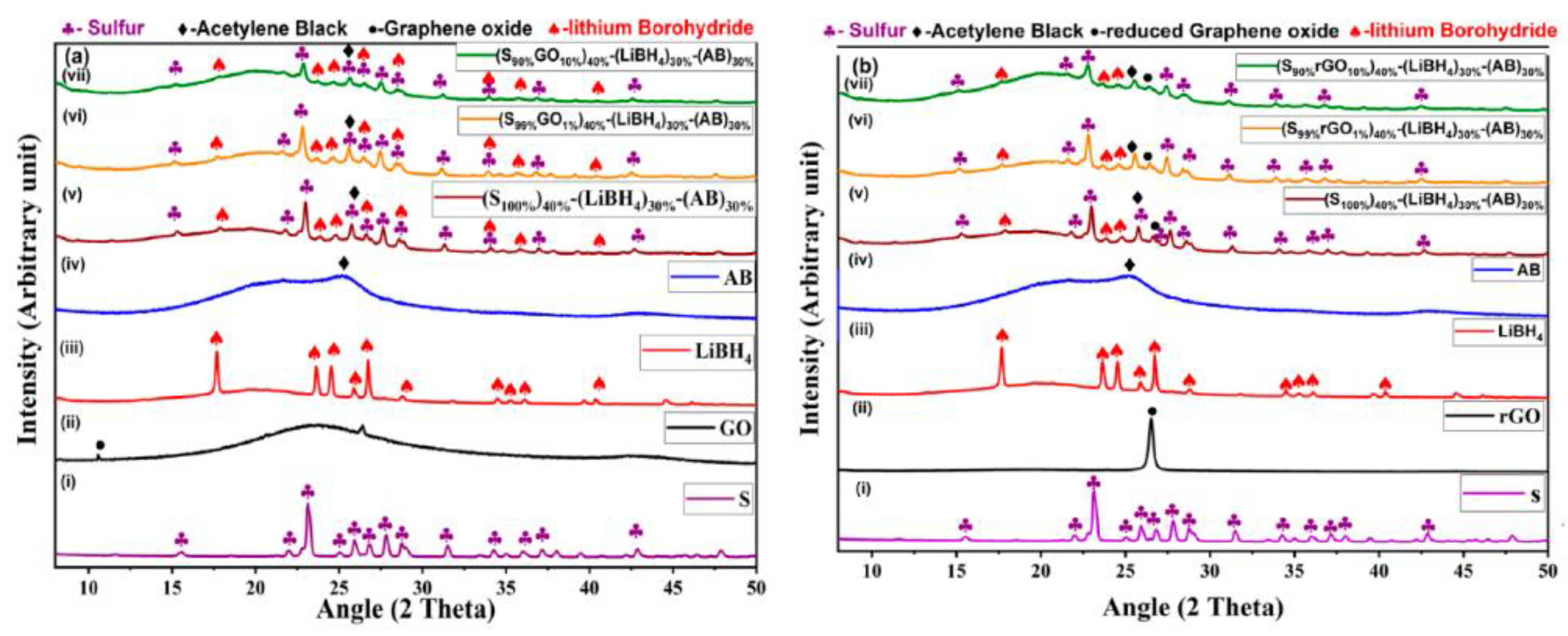
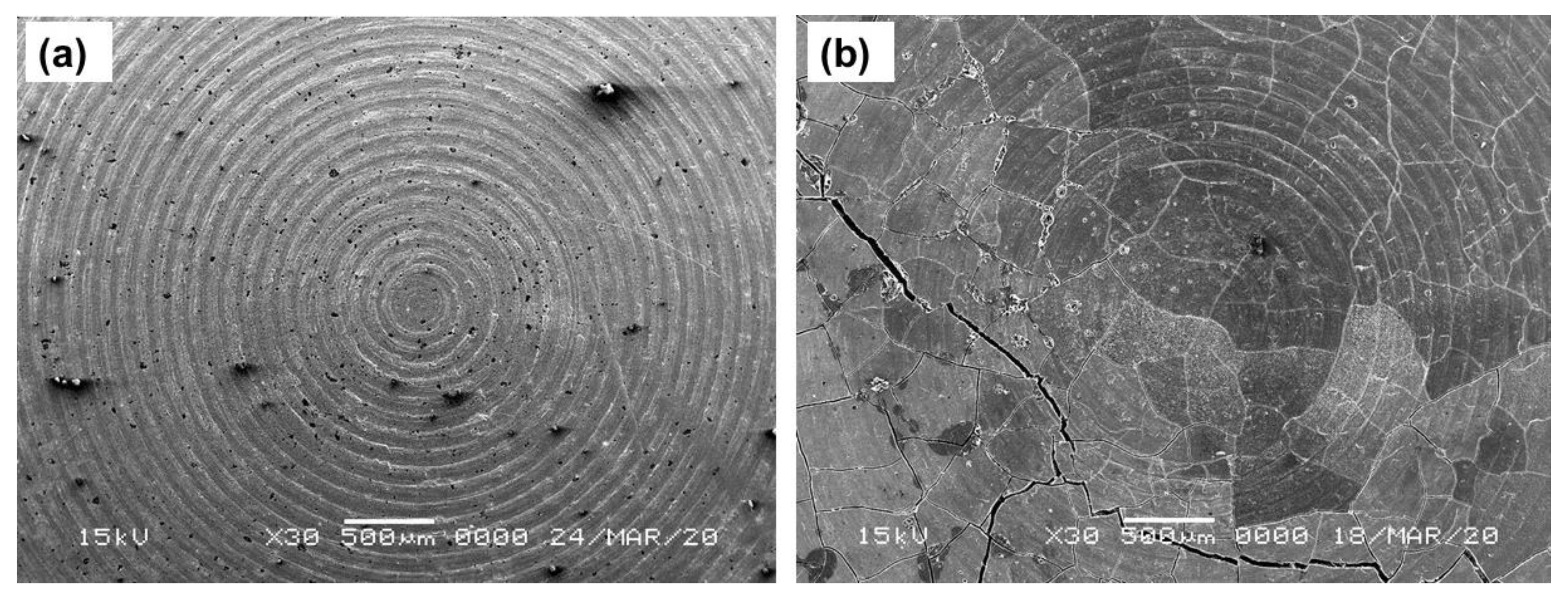

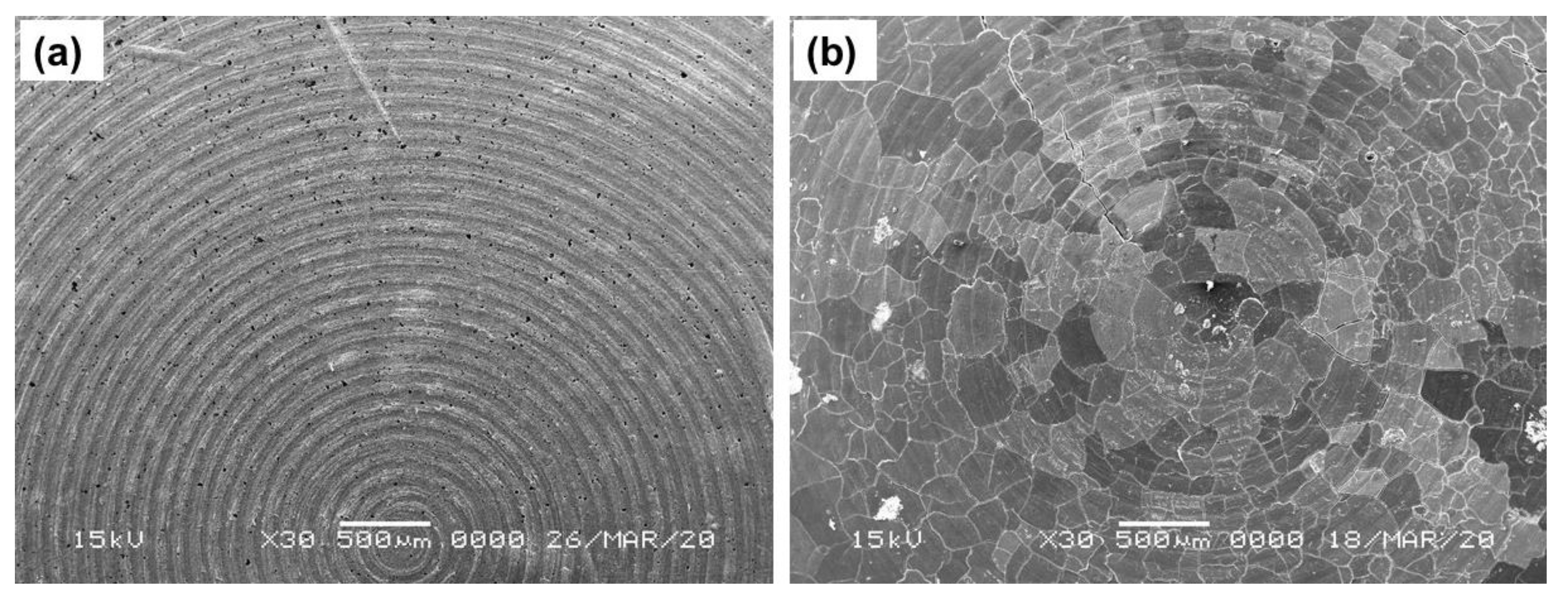
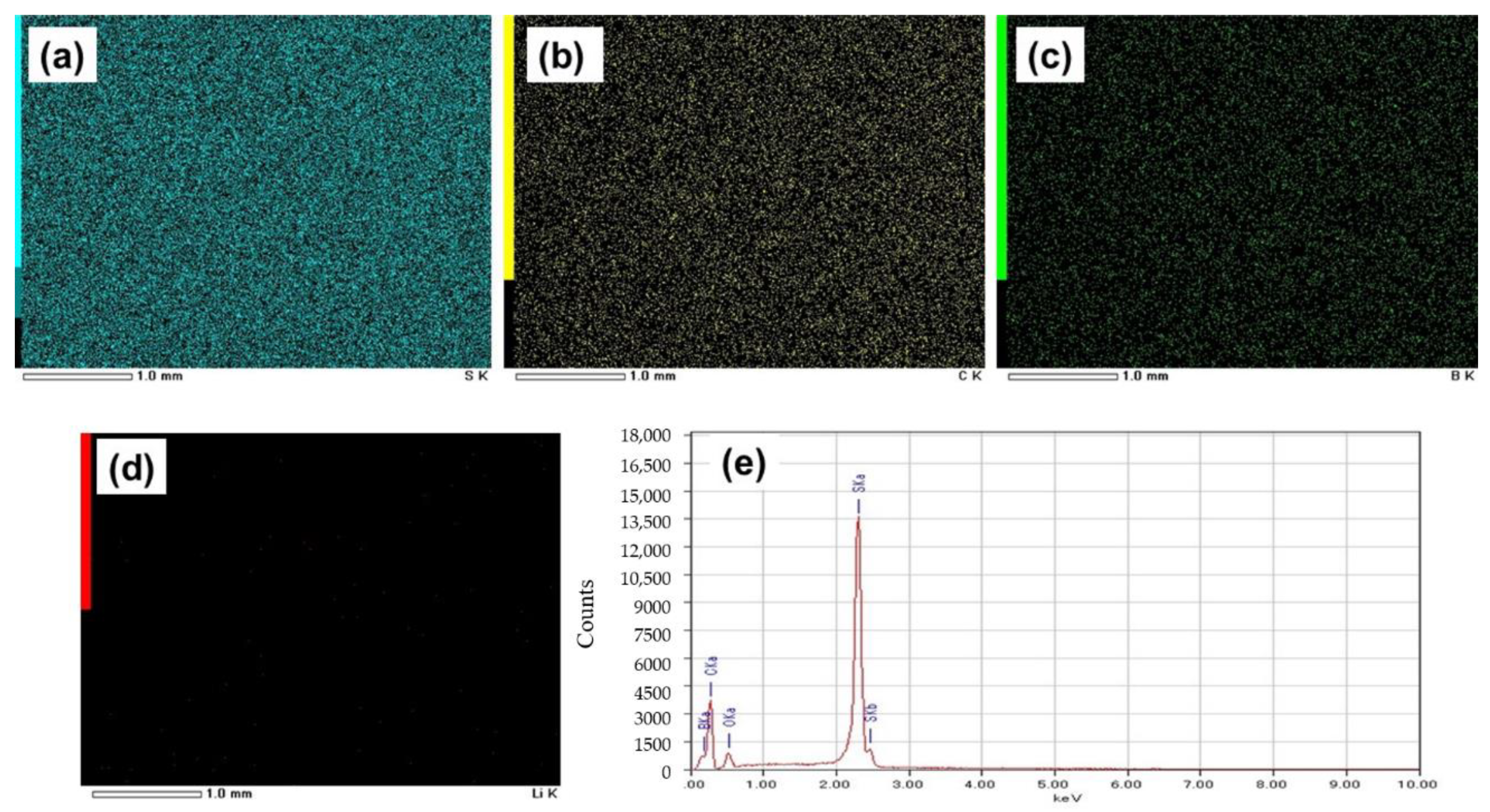
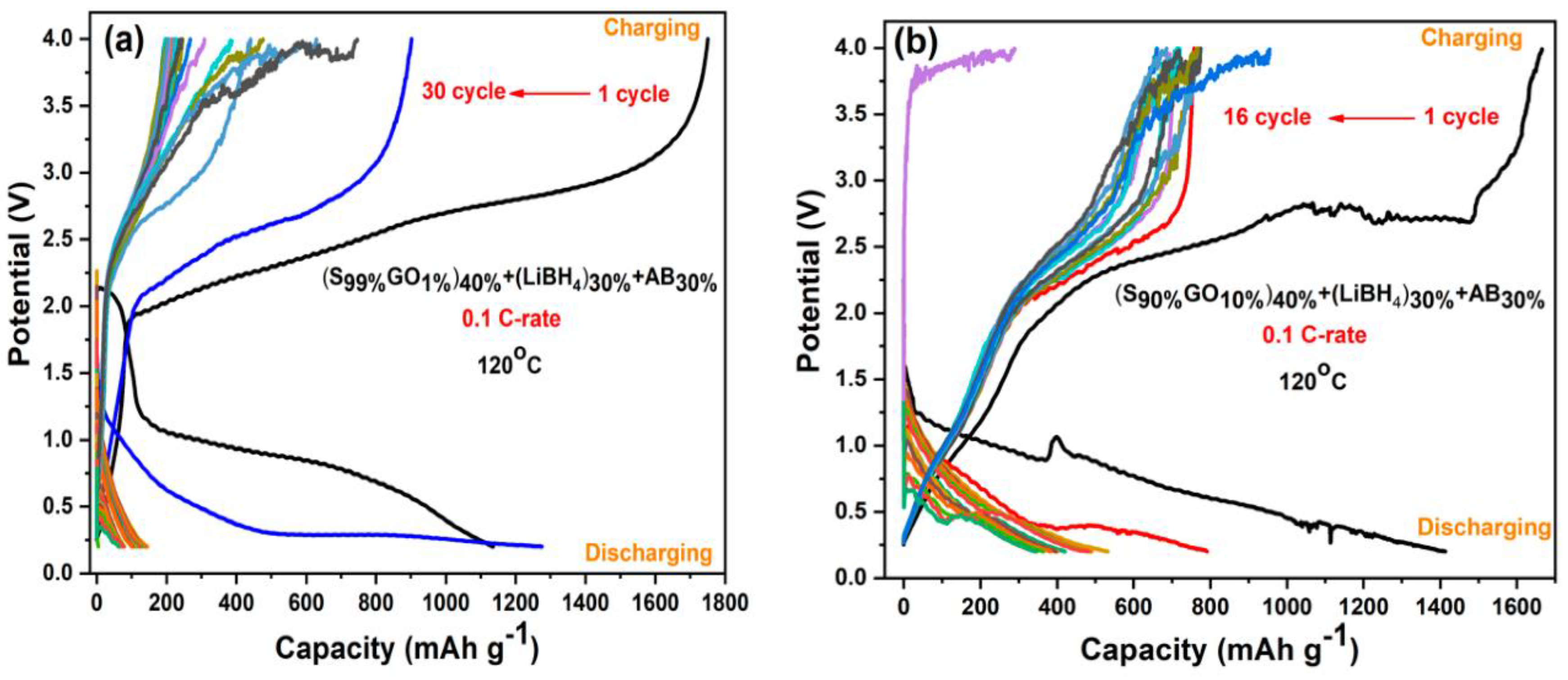
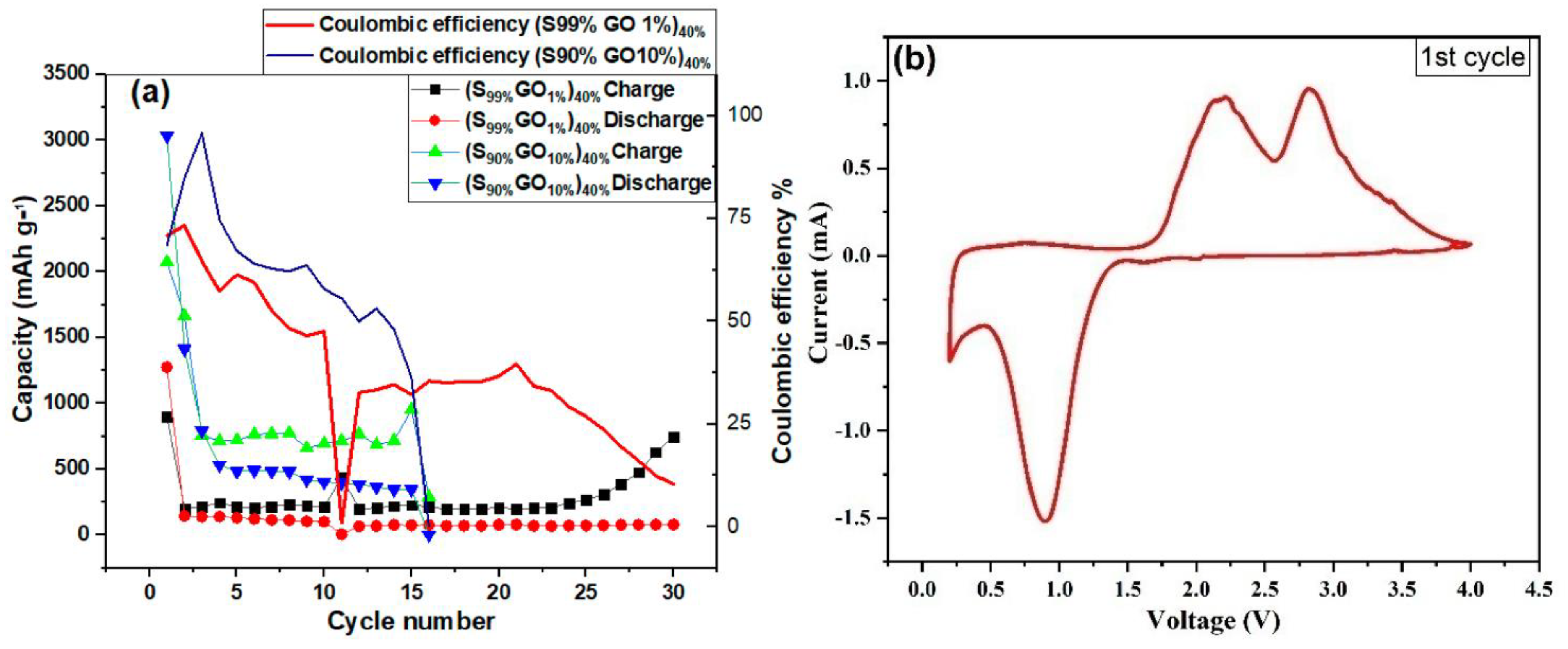
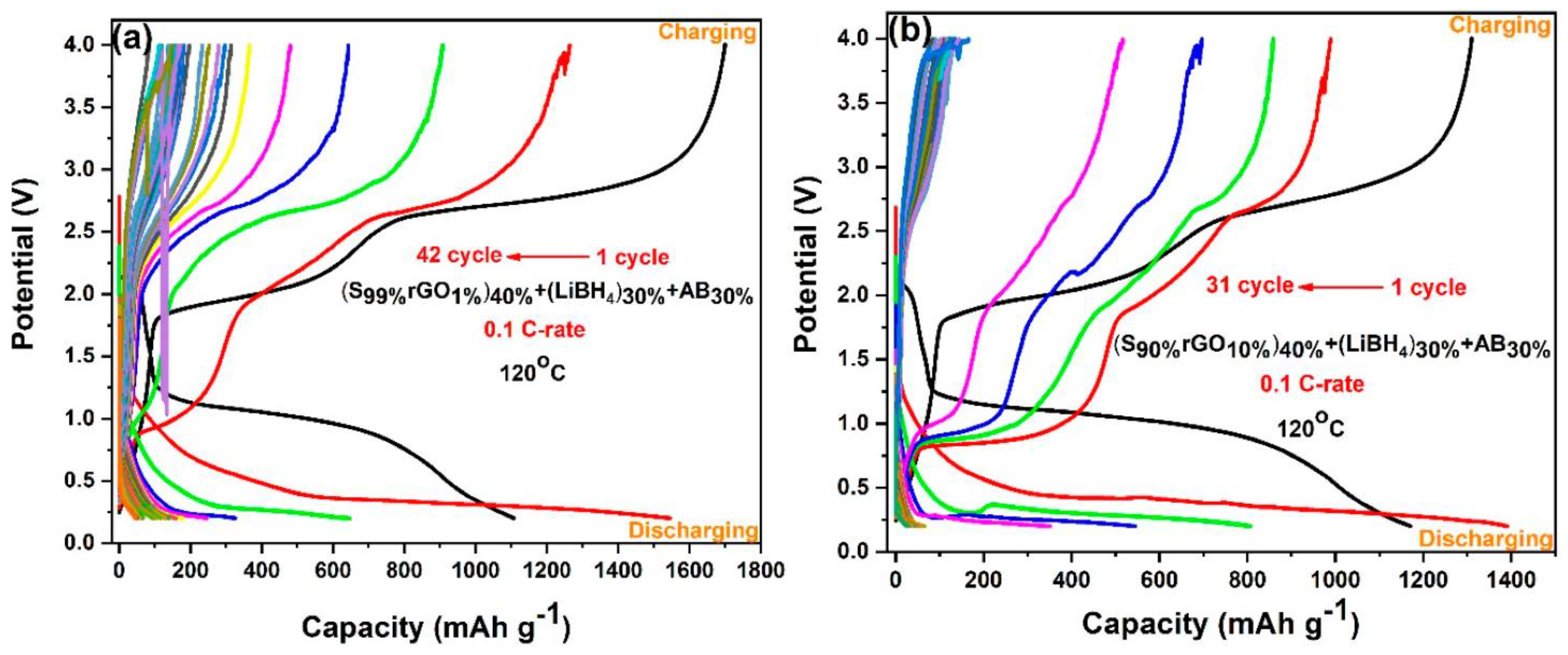
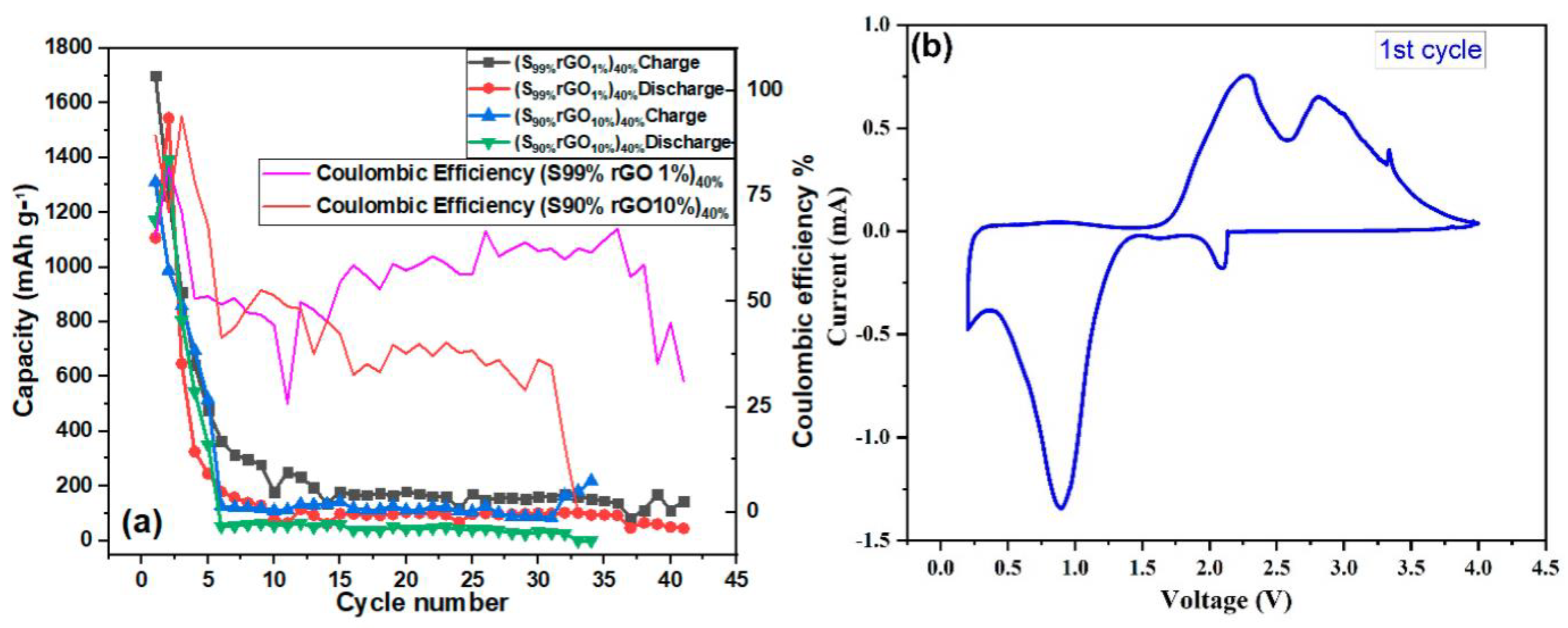
| Composite | Sulfur Content | Electrolyte | Initial Discharge Capacity (mAh/g) | C-Rate | Ref. |
|---|---|---|---|---|---|
| Graphene sheet-sulfur | 67 | Organic electrolyte | 600 | 0.1 C | [32] |
| Graphene-sulfur | 87 | 1M LiTFSI */DOL */TEGDME * | 705 | 0.33 A/g | [33] |
| rGO-S | 65 | 1M LiTFSI/DOL/DME * | 724.5 | 1 C | [34] |
| Nafion-coated FGS | ~72 | 1M LiTFSI/DOL/DME | 839 | 0.2 C | [17] |
| Expanded graphite-embedded sulphur | 80 | 1M LiTFSI/DOL/DME | 854 | 0.28 A/g | [35] |
| 3D S-CNT–rGO | 60 | 1M LiTFSI/DOL/DME | 921 | 0.1 C | [36] |
| Functionalized graphene–sulfur (FGS) | ~72 | 1M LiTFSI/DOL/DME | 950 | 0.1 C | [17] |
| CP rGO-S | 60 | 1M LiTFSI/DOL/DME | 988.9 | 0.2 C | [37] |
| Graphene-sulfur-PEG | 70 | 1M LiTFSI/DOL/DME | 1000 | 0.2 C | [8] |
| 3D Sulfur-graphene foam | 63 | 1M LiN(CF3SO2)2/DOL–DME | 1008 | 0.1 C | [38] |
| Graphene-sulfur | 73 | 1M LiTFSI/DOL/DME | 1053 | 0.1 C | [39] |
| rGO-S | 67 | 1M LiTFSI/DOL/DME | 1093 | 0.2 C | [40] |
| S-CNT | 65 | 1M LiTFSI/DOL/DME | 1100 | 0.1 C | [41] |
| S-CNT | 60 | 1M LiTFSI/DIOX */DME | 1100 | 0.1 C | [42] |
| Pristine sulphur | 100 | Li3PS4 | 1100 | 0.1 C | [43] |
| S-Ketjein Black(KB)-Maxsorb | 70 | LiBH4 | 1140 | 0.05 C | [44] |
| S-KB | 70 | LiBH4 | 950 | 0.02 C | [44] |
| S-KB (29:1) | 29:1 | LiBH4 | 910 | 0.02 C | [45] |
| S-GO | 99wt%S 1% GO | LiBH4 | 1100 | 0.1 C | Present paper |
| S-rGO | 99wt%S 1% rGO | LiBH4 | 1104 | 0.1 C | Present paper |
Publisher’s Note: MDPI stays neutral with regard to jurisdictional claims in published maps and institutional affiliations. |
© 2021 by the authors. Licensee MDPI, Basel, Switzerland. This article is an open access article distributed under the terms and conditions of the Creative Commons Attribution (CC BY) license (https://creativecommons.org/licenses/by/4.0/).
Share and Cite
Patodia, T.; Gupta, M.K.; Singh, R.; Ichikawa, T.; Jain, A.; Tripathi, B. Electrochemical Performance of Graphene-Modulated Sulfur Composite Cathodes Using LiBH4 Electrolyte for All-Solid-State Li-S Battery. Energies 2021, 14, 7362. https://doi.org/10.3390/en14217362
Patodia T, Gupta MK, Singh R, Ichikawa T, Jain A, Tripathi B. Electrochemical Performance of Graphene-Modulated Sulfur Composite Cathodes Using LiBH4 Electrolyte for All-Solid-State Li-S Battery. Energies. 2021; 14(21):7362. https://doi.org/10.3390/en14217362
Chicago/Turabian StylePatodia, Tarun, Mukesh Kumar Gupta, Rini Singh, Takayuki Ichikawa, Ankur Jain, and Balram Tripathi. 2021. "Electrochemical Performance of Graphene-Modulated Sulfur Composite Cathodes Using LiBH4 Electrolyte for All-Solid-State Li-S Battery" Energies 14, no. 21: 7362. https://doi.org/10.3390/en14217362
APA StylePatodia, T., Gupta, M. K., Singh, R., Ichikawa, T., Jain, A., & Tripathi, B. (2021). Electrochemical Performance of Graphene-Modulated Sulfur Composite Cathodes Using LiBH4 Electrolyte for All-Solid-State Li-S Battery. Energies, 14(21), 7362. https://doi.org/10.3390/en14217362








